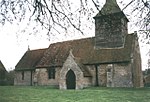Ilmer Halt railway station
Disused railway stations in BuckinghamshireFormer Great Western and Great Central Joint Railway stationsPages with no open date in Infobox stationRailway stations in Great Britain closed in 1963Railway stations in Great Britain opened in 1929 ... and 1 more
Use British English from January 2018
Ilmer Halt railway station was a former halt on the Great Western and Great Central Joint Railway serving the village of Ilmer in Buckinghamshire.
Excerpt from the Wikipedia article Ilmer Halt railway station (License: CC BY-SA 3.0, Authors).Ilmer Halt railway station
Thame Road,
Geographical coordinates (GPS) Address External links Nearby Places Show on map
Geographical coordinates (GPS)
| Latitude | Longitude |
|---|---|
| N 51.7448 ° | E -0.8849 ° |
Address
Ilmer
Thame Road
HP27 9QX
England, United Kingdom
Open on Google Maps











